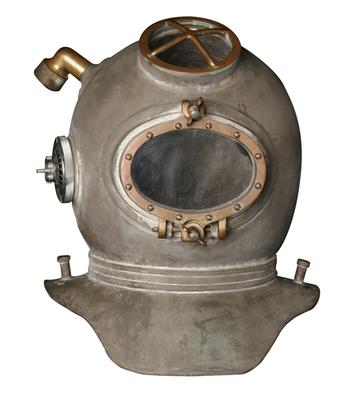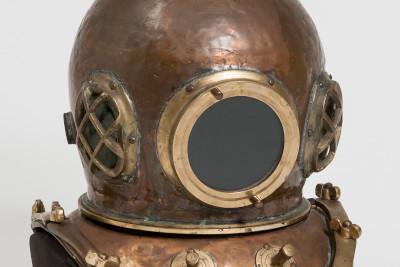Diving Helmet
Production date
1957
See full details
Object detail
Description
Siebe Gorman Mine Recovery Outfit (M.R.O) Diving Helmet, 1957
Produced by C. E. Heinke & Co by commission from the Royal Navy.
Produced by C. E. Heinke & Co by commission from the Royal Navy.
Classification
MARITIME TECHNOLOGY Diving Diver's helmet
Maker
Production date
1957
Production place
Measurements
H430mm x W360mm x D360mm
Media/Materials description
Metal, Perspex
Signature/Marks
The number 0142 is stamped (slightly left of centre) on the outer facing edge of the front light (window).
History and use
This Siebe Gorman Mine Recovery Outfit (M.R.O) helmet was built by C. E. Heinke & Co. Ltd under commission from the Royal Navy in 1957 to replace the original MROs. Only 18 were produced (Connell 2007). Its operation had a maximum depth of one hundred and twenty (120) feet (37 metres).
These helmet were originally designed in WWII to recover and de-activate German mines. At the rear of the helmet there are two (2) connections for the CO2 scrubbing canister. On the side is the telephone connection and the unusual exhaust. These helmets were worn as a two (2) piece suit. The trousers and jacket both had a rubber band around the waist. The jacket was glued over the breastplate (all in one jacket and helmet). There are two (2) lights, one centre front (hinged) and the other directly above (grill).
These helmets were a self contained rebreather unit, supplied by a nitrogen and oxygen mix. The recirculating canister on the back of the helmet scrubbed out the CO2 in the exhaled air. Because these outfits used nitrox rebreathers they did not create any air-bubbles and therefore, no sound. The helmet, shoes, and divers knife were made of non-magnetic material. When mines were cleared it was very important that the clearance diver was 'non-magnetic' and 'non-acoustic' (magnetism and sound are known to set mines off).
These helmet were originally designed in WWII to recover and de-activate German mines. At the rear of the helmet there are two (2) connections for the CO2 scrubbing canister. On the side is the telephone connection and the unusual exhaust. These helmets were worn as a two (2) piece suit. The trousers and jacket both had a rubber band around the waist. The jacket was glued over the breastplate (all in one jacket and helmet). There are two (2) lights, one centre front (hinged) and the other directly above (grill).
These helmets were a self contained rebreather unit, supplied by a nitrogen and oxygen mix. The recirculating canister on the back of the helmet scrubbed out the CO2 in the exhaled air. Because these outfits used nitrox rebreathers they did not create any air-bubbles and therefore, no sound. The helmet, shoes, and divers knife were made of non-magnetic material. When mines were cleared it was very important that the clearance diver was 'non-magnetic' and 'non-acoustic' (magnetism and sound are known to set mines off).
Associated person
Registration number
H3880




